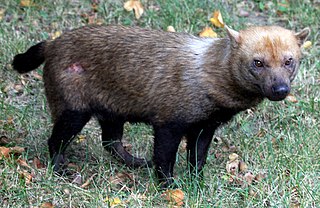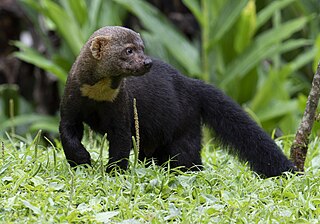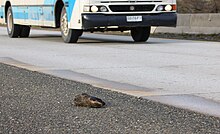
Chinchillas are either of two species of crepuscular rodents of the parvorder Caviomorpha, and are native to the Andes mountains in South America. They live in colonies called "herds" at high elevations up to 4,270 m (14,000 ft). Historically, chinchillas lived in an area that included parts of Bolivia, Peru and Chile, but today, colonies in the wild are known only in Chile. Along with their relatives, viscachas, they make up the family Chinchillidae. They are also related to the chinchilla rat.

The long-tailed weasel, also known as the bridled weasel, masked ermine, or big stoat, is a species of mustelid distributed from southern Canada through much of the United States and Mexico, southward through all of Central America and into northern South America. It is distinct from the short-tailed weasel, also known as a "stoat", a close relation in the genus Mustela that originated in Eurasia and crossed into North America some half million years ago; the two species are visually similar, especially the black tail tip.

The bush dog is a canine found in Central and South America. In spite of its extensive range, it is very rare in most areas except in Suriname, Guyana and Peru; it was first described by Peter Wilhelm Lund from fossils in Brazilian caves and was believed to be extinct.

Geoffroy's cat is a small wild cat native to the southern and central regions of South America. It is about the size of a domestic cat. It is listed as Least Concern on the IUCN Red List because it is widespread and abundant over most of its range.

The Pampas fox, also known as grey pampean fox, Pampas zorro, Azara's fox, or Azara's zorro, is a medium-sized zorro, or "false" fox, native to the South American Pampas. Azara in some of its alternative common names is a reference to Spanish naturalist Félix de Azara.

The crab-eating raccoon or South American raccoon is a species of raccoon native to marshy and jungle areas of Central and South America. It is found from Costa Rica south through most areas of South America east of the Andes down to northern Argentina and Uruguay. Despite its name, this species does not feed exclusively on crabs, and the common raccoon also seeks and eats crabs where they are available. In Paraguay, it is known as aguará or agoará popé from Guarani.

A grison is any mustelid in the genus Galictis. Native to Central and South America, the genus contains two extant species: the greater grison, which is found widely in South America, through Central America to southern Mexico; and the lesser grison, which is restricted to the southern half of South America.

The greater grison is a species of mustelid native to Southern Mexico, Central America, and South America.

The Chaco eagle or crowned solitary eagle, is an endangered bird of prey from eastern and central South America. Typically it is known simply as the crowned eagle which leads to potential confusion with the African Stephanoaetus coronatus. Due to its rarity, not much is known about its biology or population.

The Argentine black and white tegu, also known as the Argentine giant tegu, the black and white tegu, or the huge tegu, is a species of lizard in the family Teiidae. The species is the largest of the "tegu lizards". It is an omnivorous species which inhabits the tropical rain forests, savannas and semi-deserts of eastern and central South America.

The short-tailed chinchilla is a small rodent part of the Chinchillidae family and is classified as an endangered species by the IUCN. Originating in South America, the chinchilla is part of the genus Chinchilla, which is separated into two species: the long-tailed chinchilla and the short-tailed chinchilla. Although the short-tailed chinchilla used to be found in Chile, Argentina, Peru, and Bolivia, the geographical distribution of the species has since shifted. Today, the species remains extant in the Andes mountains of northern Chile, but small populations have been found in southern Bolivia.
The ashy chinchilla rat is a species of chinchilla rats in the family Abrocomidae found in Argentina, Bolivia, Chile, and Peru.

Oligacanthorhynchida is an order containing a single parasitic worm family, Oligacanthorhynchidae, that attach themselves to the intestinal wall of terrestrial vertebrates.

The tayra is an omnivorous animal from the weasel family, native to the Americas. It is the only species in the genus Eira.

Pachysentis is a genus in Acanthocephala that parasitize primates and carnivorans. They are distributed across Africa, the Middle East, and the Americas. Pachysentis species attach themselves to the inner lining of the gastrointestinal tract of their hosts using their hook-covered proboscis. Their life cycle includes an egg stage found in host feces, a cystacanth (larval) stage in an intermediate host such as the Egyptian cobra, and an adult stage where cystacanths mature in the intestines of the host. This genus appears identical to the closely related Oncicola apart from a greater number of hooks on the proboscis. There are eleven species assigned to this genus, although P. septemserialis is of uncertain taxonomic status. The female worms range from 12 millimetres (0.47 in) long and 1.6 millimetres (0.063 in) wide in P. lauroi to 50 millimetres (2.0 in) long and 4 millimetres (0.16 in) wide in P. dollfusi. Virtually all of the length is the trunk, with a short proboscis. There is pronounced sexual dimorphism in this species as females are around twice the size of the males.

Enhydrictis is a genus of extinct mustelid, belonging to the subfamily Galictinae. The type species, and best known, is Enhydrictis galictoides from the Pleistocene of Sardinia and Corsica. Some authors attribute species from mainland Eurasia to the genus, but this is disputed, with others considering the genus endemic to Sardinia-Corsica.




















